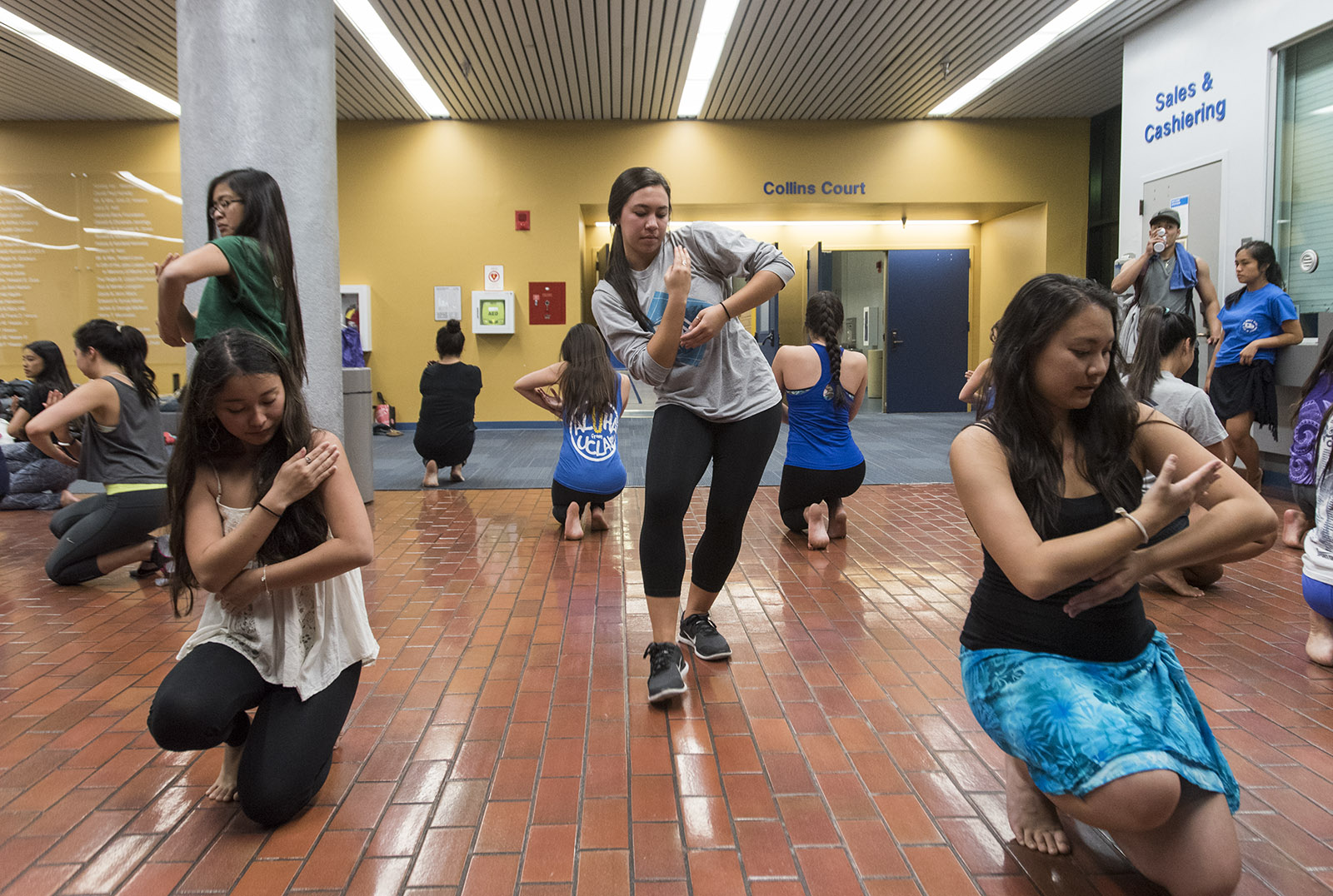Hawaiian luau brings students together to rediscover their cultural roots

Hui O’Imiloa, the Hawaii Club at UCLA, will host its 31st annual luau Saturday in Ackerman Grand Ballroom, uniting students of different enthnicities to show authentic Hawaiian culture and dance. (Kathy Chen/Daily Bruin)
By Sally Lee
April 29, 2016 12:29 a.m.
Luau performers scrambled to their rehearsal positions with the playful, nimble sound of the ukelele on one side of the room and the mighty beats of tribal drums on the other.
Each year, the Luau is a chance for performers to share the meanings behind each dance with the UCLA community and beyond, said Dayna Sakata, a fourth-year business economics student.
Hui O’ Imiloa, the Hawaii Club at UCLA, will host its 31st annual luau featuring Hawaiian and Polynesian dances mostly taught by professional dancers and performed by UCLA students. The luau unites students of different ethnicities with the same aim of Hawaiian authenticity and group bonding, said Sakata.
The club’s dancers have performed at UCLA events and venues like World in Sight, Feast dining hall, Dance Marathon at UCLA and the Ballroom Dance Club. Each fall quarter, the club provides hula dance workshops to the public.
Born in Hawaii and raised in California, Sakata, co-president of the Hawaii Club at UCLA, said her family in Hawaii played a major role in her upbringing.
Her family moved from Japan to Hawaii at least three generations before Sakata . Although her family is from Japan, she finds that her experience growing up is more tied to Hawaiian and Californian lifestyles.
“Joining the Hawaii Club and dancing in the luau are ways for me to learn a huge part of my upbringing that I have self-internalized,” Sakata said. “It’s a way for me to rediscover my roots.”
Because Sakata had no dance experience before joining the club, she said she could not outwardly show her and her family’s culture.
On the other hand, Courtney Shibuya, a fourth-year business economics student and the club’s co-president, said she has been performing and competing in Hawaiian dances since first grade. Dancing was one of her favorite after-school activities.
“When I came to college, I wanted to find somewhere to have that same experience (as my childhood),” Shibuya said.” Dancing in the luau is my creative outlet.”
Along with dancing in the Hawaii Club, both co-presidents said they visit their extended families in Hawaii every year to foster their understanding of where the three generations before them lived. English is the language spoken at home, but Sakata and Shibuya desire to learn Japanese, the language spoken in the many generations before them. They said the language was not passed down.
Being involved in the luau is a step toward being in touch with the lifestyle that their families experience living in Hawaii, Sakata and Shibuya said.
The luau provides student dancers a space for self-expression and an educational resource to learn Hawaiian and Polynesian dance styles. It also offers the audience insights into how common stereotypes are incomplete portrayals of Hawaiian and Polynesian culture, Sakata and Shibuya said.
Sakata said traditionally, in some aspects of the public and especially through the media, coconut bras and grass skirts have symbolized Hawaiian culture. One role of the dancers in the upcoming luau is to explain the deeper meanings of the dances beyond the coconut bras and grass skirts.
“You only see Hawaiian culture and Polynesian culture portrayed in one single way, but there is actually more to the culture,” Sakata said.
Carmela Delda, a third-year psychobiology student and one of the luau’s choreographers, said each dance explains an aspect of the culture: ancient mythology, the Hawaiian islands, weather, love stories and more.
Unlike some other dancers, Delda said she is a Filipina with no Hawaiian ethnic background. Since a young age, she has always been intrigued by Hawaiian culture through books she had read. She sought to join a Hawaiian culture club at UCLA because she was in a Polynesian Club at her high school. Now, by participating in the luau, she has learned and taught choreography as a way to better understand the stories told through the dances.
Knowing the history behind the dances also allows them to know what costumes to wear for each dance number, Sakata said. Colors are important in representing different aspects of Hawaiian culture. For example, pink signifies Maui, she said.
Club member Lauren Daggett, a third-year psychobiology student, said that at the luau, the dancers wear fabric skirts and flowerhead pieces for the hula. Other outfits include flower belts around the hips and tops made of leaves, flowers and shell bras for Tahitian dances. Also, the dancers wear tribal clothing for poi balls, a traditional Maori dance.
“There are still so many people that do not know about (the diversity of Hawaiian dances) and it’s interesting to see how it’s growing still,” Daggett said.
Daggett learned dance at her first grade teacher’s Hawaiian dance studio. Daggett’s Japanese, Caucasian and Hawaiian ethnicity also inspired her to gain more understanding of her self-identity through cultural dances, Daggett said.
Growing up in Orange County, Daggett did not know students who also engaged in Hawaiian and Polynesian dances.
The four students, Sakata, Shibuya, Delda and Daggett said they found a sense of community in the club that has paralleled and bolstered Hawaiian culture’s importance of family, “Ohana.”
“I’m really happy to have the club here as a second home to me,” Daggett said. “It’s nice to have a group on campus that has (people with) the same passion as you.”


